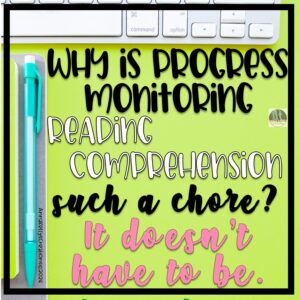It’s that time again.
IEP time.
I know it can be overwhelming, but it doesn’t have to be. With the help of your IEP team, this working document can reflect the ideas of several people, taking some of the work off of your plate. Let’s take a look at how we can help everyone feel like their voice has been heard!
Giving everyone the opportunity to contribute isn’t too hard as you complete these 5 must-do tasks in preparation for completing an IEP.
1. Collect Data
Data is one of the most important parts of an IEP, and it can exist in different formats. Whether your team is collecting official documents like progress reports and prior IEPs, frequently conversing with guardians, or documenting interactions with students, all of these data points are vital to creating an IEP that is accurate and thorough.

Encourage your IEP team and other professionals in your building who work with the student to share any of the data that they have collected. Giving others the opportunity to contribute their work samples and data points to the conversation helps them to feel included in the process.
2. Send Out Surveys
Surveys are an easy way to ensure that all voices are heard. Send them out to guardians, general education teachers, and the students themselves to gauge areas of strength, concern, and other vital information that may need to be shared in order to update or craft an IEP.
My students aren’t always able to complete paper surveys or express their thoughts in writing, so I complete it with them and use it as an opportunity to work on relationship building with my students.
When I send out these surveys to teachers, I always try to make them as easy as possible to fill out. I like to use a Google Form for student specific goals and accommodations. I also leave a spot for teachers to share their areas of interest with the IEP team.
I have student and parent surveys already made for you in my store. Click here to take a look.
3. Send Out Drafts & Request Feedback
Best case scenario, I try to have a due date looming in my head, and then go back a week’s time to ensure I’ll be able to get the draft sent home and returned in ample time, but if you’re anything like me, you still feel like you’re rushing to get it sent out and returned. So, this is your reminder to go put that one meeting on your calendar! Mark a date a week before to remind yourself to send home that draft. You’re welcome.

As you’re sending this IEP draft home, please communicate with guardians to remind them that this is a working document, and not concrete. All input will be considered throughout the process and can be added in at any point.
To learn more about how I set myself up for success at the beginning of the year check out my post on: An Inclusion Teacher’s First Week of School
4. Ask Questions & Check-in
IEP meetings may feel awkward for those who don’t regularly attend them, but please consider giving these attendees a job so that everyone feels included. Even if a teacher or administrator usually sits quietly through meetings, they can still be given the role of notetaker to ensure their active participation. Attendees can also report additional feedback during a specified time within the meeting.

5. Gather Input from Everyone
Make sure that everyone has had a chance to speak before the meeting ends. We want all input and concerns to be addressed and considered.
If your students are in middle school or high school, invite them to their IEP meeting! This helps empower them to speak up and share their own goals while also adding another perspective to the meeting.

It can also show them that they have an entire team of adults who are there for them, rooting for them to succeed, and communicating about their progress toward achieving their goals. As students get older their involvement in creating and implementing IEPs is important, especially as they transition through schools and into their after high school plans.
Helping all voices to be heard during an IEP meeting doesn’t sound that hard now, does it? Now you know some of the ways to include the whole team in the process. Don’t be afraid to stand your ground, seek advice, and consider all viewpoints.
Is it time to start thinking about Transition Plans? This is another crucial part of the IEP that needs to involve the whole team. Caroline at Celavora Education has a very helpful blog post with steps to take and resources to use for this process. Check out her post “Individual Transition Plan How to Guide for Special Ed Teachers.”





Pingback: Beginning of year special education forms - Inclusion Teacher’s first week